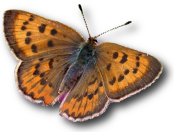 Art Shapiro's Butterfly Site
Art Shapiro's Butterfly Site
Monitoring butterfly populations across Central California for more than 35 years… Elizabeth Long
I moved to the Los Angeles area in late August of 2014. There I will work as a postdoctoral fellow at the Natural History Museum of Los Angeles and the UCLA La Kretz Center for California Conservation Science. I am surveying butterfly communities in the Santa Monica Mountains and also in urban LA via the museum’s BioSCAN project. In my studies I use a combination of field work, genetics/genomics techniques, and experimental approaches.
For my dissertation work, I studied a fascinating female-limited polymorphic mimicry system in two species of western checkerspot butterflies. As the name implies, the Variable Checkerspot, a.k.a. the Chalcedon Checkerspot, Euphydryas chalcedona, has a highly variable phenotype. Many populations have a strong reddish background color, while other populations exhibit a black background color. The Northern Checkerspot, Chlosyne palla, is a putative mimic of E. chalcedona, and its phenotype also varies. Where the 2 species do not co-occur, C. palla of both sexes are red. Where they do co-occur and E. chalcedona is red, both sexes of C. palla are red. However, where E. chalcedona is black, C. palla males are red and females are red, black, or intermediate. While both the black and red forms of C. palla appear to mimic E. chalcedona, the black form seems to be an especially strong mimic.
I'm interested in the evolutionary and ecological factors that govern the polymorphism in C. palla, and how this polymorphism interacts with other Chlosyne species, many of which co-occur with E. chalcedona but none of which exhibit the female-limited black phenotype. To address these questions I'm using molecular markers to look at differentiation both within and between species.
I can be reached at eclong@ucla.edu or elong@nhm.org